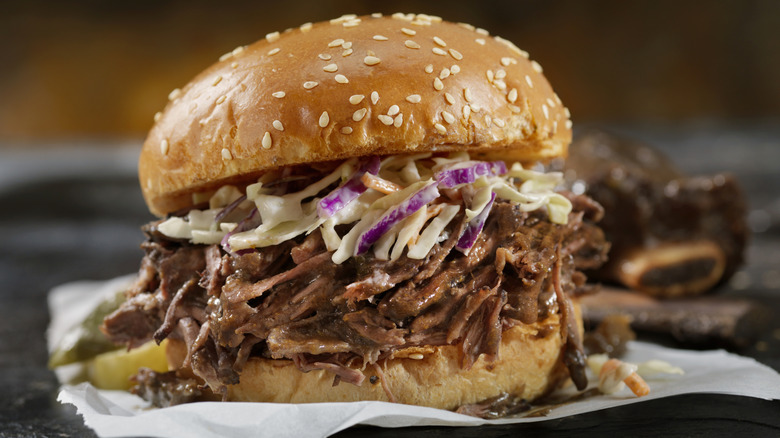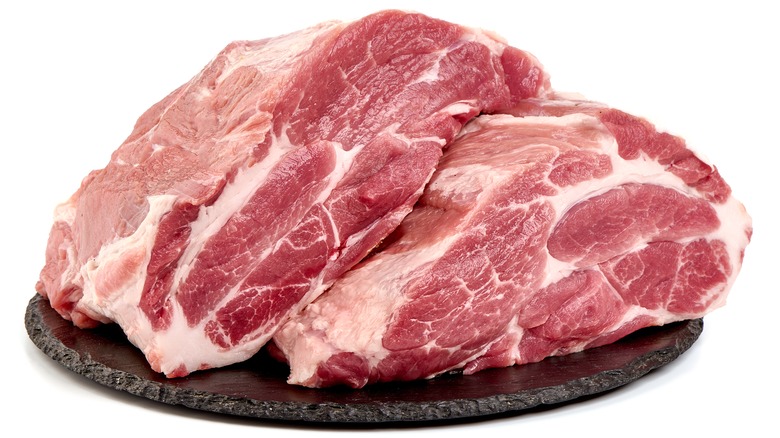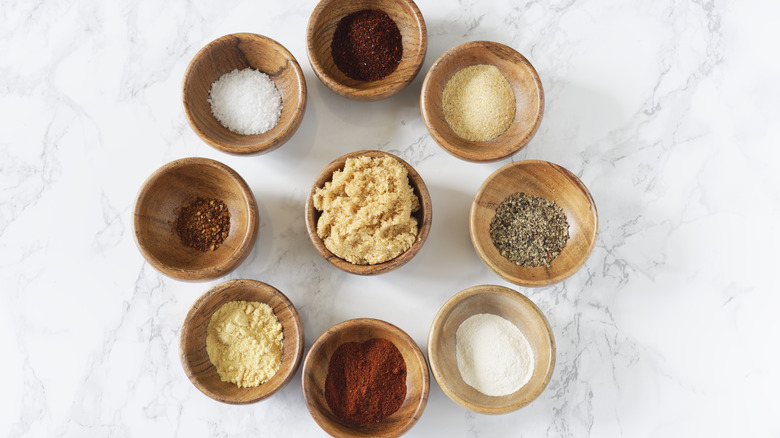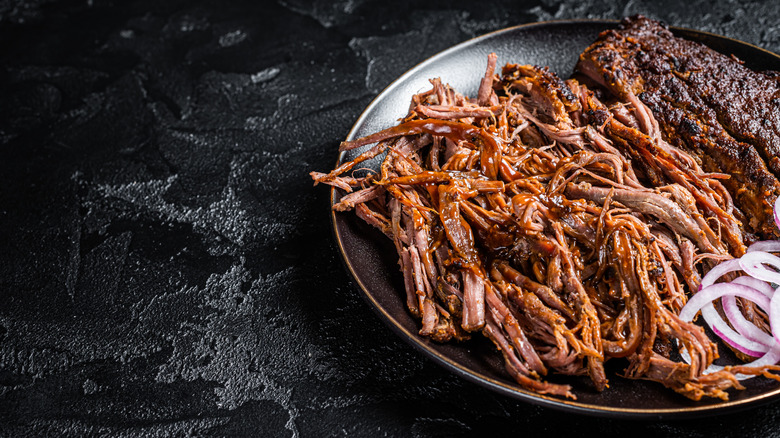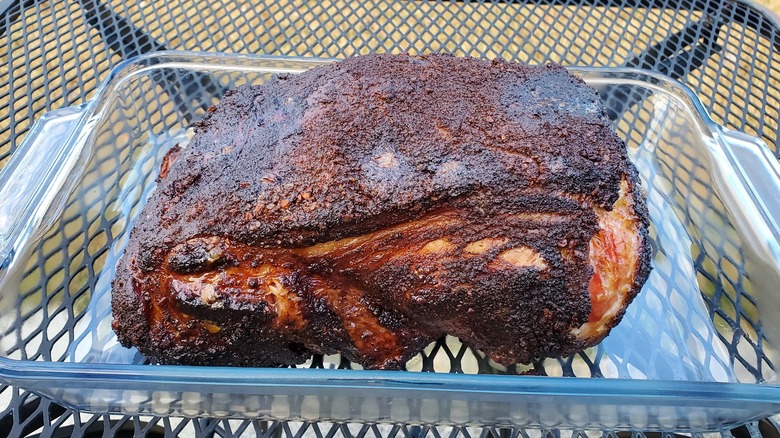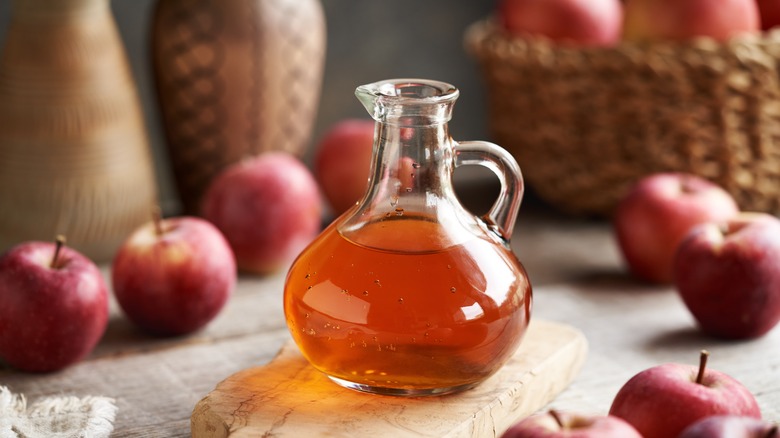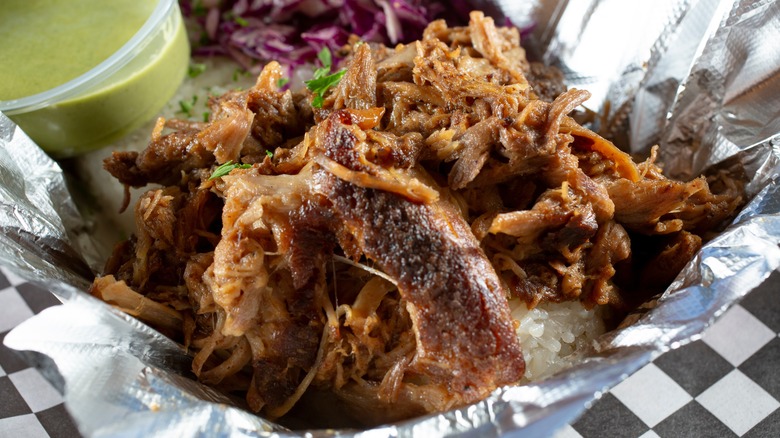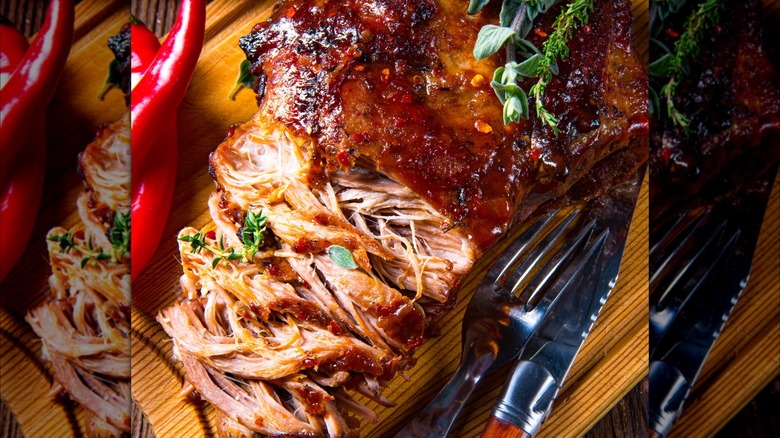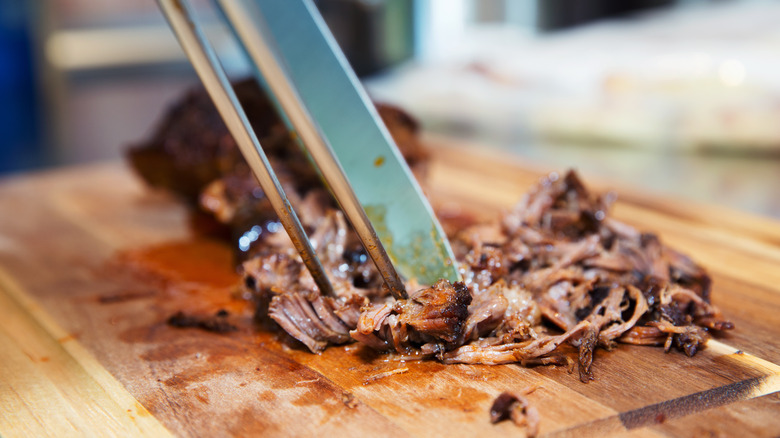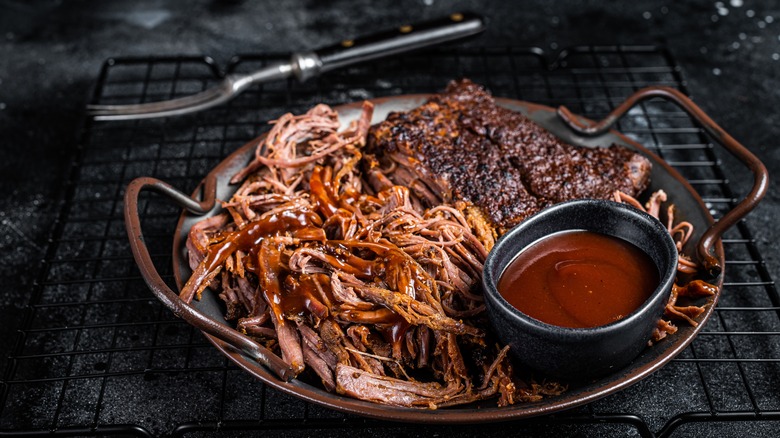10 Ways To Take Your Pulled Pork To The Next Level, According To BBQ Pros
It's hard to find a carnivore who doesn't like pulled pork. Usually made from slow-cooked pork shoulder, or pork butt, the tender, succulent, and flavorful meat is a barbecue favorite, particularly in the Southern U.S. Not only is it melt-in-the-mouth delicious, but the culinary classic can be served in a variety of ways, from pulled pork sandwiches to pulled pork pizza. Provided that it has been cooked correctly, pulled pork is also flavorful enough to stand on its own, alongside side dishes such as coleslaw and traditional mashed potatoes.
There are several different ways of preparing pulled pork at home. While the oven might be the obvious choice for many, some swear by the tenderness and flavor of pulled pork prepared in a slow cooker or a smoker. Whatever method you choose, following a few basic rules can mean the difference between tender, juicy pork, or dry, tough meat. In our quest to discover how to make the perfect pulled pork, we have asked a handful of experts to share their insights on how to prepare, cook, and serve this delicious protein.
Ready to take your pulled pork to the next level? Keep reading for some tips from the BBQ pros.
1. Select the right meat and trim the fat cap
Pulled pork is made from pork shoulder, often referred to as the Boston butt. The cut is well-marbled and has a good balance of meat and fat. Since the shoulder muscle does a lot of work, the cut is also relatively tough, making it perfect for slow-cooking. The pork shoulder can be cooked boneless or bone-in, depending on preference. Barrett Black, a fourth-generation Pitmaster at The Original Black's Barbecue in Texas, explains: "The butt is cut from a higher portion [of the shoulder], giving it a more uniform shape — ideal for long, slow smoking."
While there are different schools of thought about how to prepare the meat for cooking, Chef Craig Norman from the Water Pig BBQ Restaurant in Pensacola, Florida, trims the fat cap on his Boston butts down to ¼ inch. "This will protect your meat during the cooking process. This fat will baste the meat during the breakdown process of smoking," he explains.
Conversely, Black says that he doesn't trim the fat cap on his Boston butt, allowing it to render down and infuse the meat. "One unique step we take is cutting the pork butt into softball-sized chunks before smoking. This increases the surface area for bark development, which is where you get that deep, smoky, salty crust — arguably the best part of any smoked meat. Plus, smaller pieces cook faster, so it's a win-win," Black adds.
2. Create the right spice rub
The quality of the spice rub can make a difference between shredded pork that's full of flavor and bland pieces of meat. According to Chef Craig Norman, the rub is also the simplest, yet most difficult, aspect of preparing shredded pork to perfect. "The most perfect rub to one person isn't the same as what another may like. [...] The rub comes with practice and failure. They all taste pretty darn good, but it's just about honing in on your preferences," he explains.
So what are some of the rub ingredients recommended by professionals? Norman says that his pork rub includes a mix of Kosher salt, sugar, paprika, black pepper, granulated garlic, onion powder, and crushed pepper flakes. Pitmaster Barrett Black says that he likes to keep his pork rub simple, adding, "For the initial cook, we season with just table salt and coarse black pepper to let the smoke shine. After the pork is smoked and pulled, we add a bit more seasoning, including a touch of garlic powder." Meanwhile, Chef Brandon Rushing of Briny Swine Smokehouse & Oyster Bar with locations in Chicago, Illinois, and Edisto in South Carolina, says that his restaurant uses a signature pork rub. "[It's] a blend of paprika, sugar, brown sugar, black pepper, and a whole host of other spices," he adds.
When it comes to spices, Chef Norman recommends erring on the side of caution, saying, "It is always easier to add more than try to take some away." While Norman warns against over-seasoning the meat, he is a fan of taking time. "We wrap [the pork] and refrigerate overnight. This will ensure the salt and sugar will start breaking down some of the fat and introduce seasoning inside the pork," he says.
3. Infuse the pork with a marinade
While most experts agree that a rub is essential to imbuing pulled pork with flavor, not everybody is a fan of marinades. In fact, whether to marinate or not is a matter of preference. Nobody knows this better than John Jr. McLemore of The McLemore Boys, a father and son BBQ pitmaster duo who have released a cookbook called "Gather & Grill" and two Lane's BBQ meat rubs.
While John Jr. says that a spice rub is the key to flavorful pulled pork, he also specifies that this doesn't necessarily apply to marinades. "You can absolutely marinate your pork shoulder but it's not a must for good results, it just depends on what you are wanting to accomplish flavor wise. [...] If you want to make a marinade you should look at using something that has a salt base in it, which will help break down the pork during the cooking time," he says. While the other part of the father and son duo, John McLemore agrees, he also adds that he likes to use a binder — such as mustard — to his rub to help it stick to the pork.
4. Refrain from searing the pork
While some home chefs swear by searing pork in a skillet prior to slow-cooking, most experts agree that doing this can be counterproductive. More specifically, fans of searing say that browning the meat before placing it in a slow cooker or a smoker adds flavor and texture to the meat.
Many pulled pork enthusiasts view searing as an optional step that can imbue the meat with a deeper flavor. Others are adamant that searing pork prior to cooking is actually detrimental to the final result. Pitmaster Barrett Black says that there's absolutely no reason to brown pork before popping it in a smoker. "We let the post oak smoke do the work for us. It develops a beautiful, flavorful bark naturally, so there's no need to sear. The smoke does all the heavy lifting here," he explains. John Jr. McLemore of The McLemore Boys echoes this sentiment, saying, "Do not sear before smoking/cooking [the pork]. Pulled pork needs time to cook low and slow and searing it would not allow for this."
5. Don't rush the cooking process
Whether you're preparing pulled pork in a slow cooker or a smoker, patience is crucial. If you want tender, fall-off-the-bone pork, it's essential to give the meat sufficient time to break down the tough connective tissues. While different experts like to cook their Boston butt at slightly different temperatures and time periods, they all agree that low and slow is the key to perfectly cooked pork.
Chef Craig Norman recommends smoking Boston butts at 225 degrees Fahrenheit for around 12 to 14 hours. "The hardest thing to do in cooking is just leave it alone. This applies to BBQ more so than other techniques, but the mindset is the same. BBQ happens by letting smoke slowly break down the roughest meats and turning it into the most mouthwatering meat one has ever eaten," he says. "When the meat reaches 165 degrees, we remove and wrap [it]. At this stage the butt is cooked but we finish the breakdown process. Wrap it fully in plastic wrap followed by butcher's paper and return to the smoker until it reaches 200 degrees."
Chef Brandon Rushing has a very similar strategy when it comes to preparing pulled pork. "I prefer to start the cooking at 250 [degrees Fahrenheit] and then let it go down to 201 degrees. When the meat is at an internal temp of 165 —170 degrees, we wrap it in butcher paper. But at home, you can use foil or place it in a foil pan," he says.
6. Keep the pork moist during the cooking process
While Boston butt is a relatively well-marbled cut of pork, like any other meat, it can dry out during the cooking process. This can happen for a variety of reasons, including preparing the meat in overly high temperatures or cooking it for too long. Luckily, there're a few easy ways that can help ensure that your pork stays moist and tender.
Chef Craig Norman says that one of the best ways to keep Boston butt moist during cooking is to prepare it with the fat cap facing up. "This will help the juices drip down to fall over the meat," he says. Norman also specifies that he sprays his cuts of pork with a combination of apple cider vinegar, apple juice, and liquid butter to keep it nice and tender. In fact, apple cider vinegar-based brines are quite popular since they not only add moisture back to the meat, but also imbue it with a subtle sweetness.
7. Don't discard the pork juices
The natural juices released by pork butt during the cooking process are packed with flavor. Instead of discarding them, you can use these drippings to add flavor and moisture to your dish, or turn them into a sauce. John Jr. McLemore says that he sometimes takes the drippings from the pork shoulder midway through the cooking process and re-injects them into the meat. This is usually done with a meat injector, a large syringe-type kitchen utensil that lets him distribute the drippings throughout the meat. Meanwhile, Pitmaster Barrett Black calls these pork drippings "liquid gold," adding, "We save every bit of it. After pulling the pork, we mix some of those smoky, flavorful juices back in. It keeps the meat moist and adds an extra layer of richness."
If you don't add them back into the meat, pork drippings can have plenty of other uses. Carey Bringle, the Founder of Peg Leg Porker, a BBQ restaurant in Nashville, Tennessee, routinely collects pork juices. "One thing that we often do is cook our green beans or baked beans below the pork and let those great juices drip into them for more flavor," he says. Pork drippings can also be used to make au jus, as explained by Chef Craig Norman. "Take the juices from the pan and add white wine, shallots, [and] bay leaves to make a pork au jus," he says, adding that he normally serves the meat drippings with tater tots.
8. Let the pork rest
Once cooked, the pork should be allowed to rest before it's shredded. As much as you might want to begin, there's a good reason why you should resist the urge to start shredding the meat right away. During the cooking process, the juices in the protein move outwards. Cooling the meat redistributes these juices through the meat, making it more tender and flavorful. In addition, the butt will continue to cook for around 30 minutes after it's removed from the heat source, which could be essential for the final tenderness of the meat.
Chef Craig Norman, who wraps his pork butt when it reaches 165 degrees Fahrenheit in the smoker, recommends keeping the meat wrapped during the resting phase. Norman also advises that the pork should rest for at least an hour, though he says that for best results this time period can be extended to around four hours. "This will help all those juices lock into the meat. When the meat is unwrapped from the butcher's paper and plastic wrap, it will be as tender and juicy as you can dream," he explains.
9. Shred the pork the right way
Once the pork butt has rested and cooked, it's time to begin shredding the meat. If it's been prepared correctly, the pork butt should be tender enough to make this job both easy and satisfying. While many chefs have slightly different shredding methods, the end result should be the same: wonderfully juicy and flavorful pieces of pork.
The most commonly used method to shred pork involves using a kitchen utensil to pull the meat apart. While some chefs utilize two forks or meat claws to do this, Chef Craig Norman prefers to use a pair of tongs. "While [the pork is] still in plastic with one slice across the top I use a pair of tongs and insert and twist — for the perfect ratio of meat to fat. Removing and scooping this way ensures that all the juice from the breakdown process gets mixed back in as you use the tongs to grab the pulled pork. I simply pull and twist it out."
Other experts recommend hand-shredding pulled pork for maximum control over the process. For instance, Carey Bringle says that the meat should fall apart easily, adding that he usually wears gloves during the process to prevent any potential burns if the meat is still hot. Pitmaster Barrett Black seconds this, saying, "If the pork isn't tender enough to pull apart with just your hands, it needs more time on the smoker. A gentle squeeze should easily shred it."
10. Serve the shredded pork with your favorite sauce — or not
How the shredded pork is served is a matter of preference. Some enjoy the meat in pulled pork sandwiches, others are partial to pulled pork tacos or pulled pork baked potatoes. Many purists prefer the meat on its own, served with sides such as coleslaw or grilled vegetables. Some home chefs also enjoy mixing pulled pork with a sauce or serving it with a small bowl of condiment on the side for dipping. Perhaps the most popular option here is classic BBQ sauce, although mustard-based sauces and vinegar sauces are also popular.
While pulled pork can taste great with a variety of sauces, some culinary professionals say that the meat technically shouldn't need a condiment if it's been cooked correctly. Chef Craig Norman is one such expert. "I want to be able to taste the hard work put into that rub. I want to taste and smell the wood and smoker you used. I think the greatest thing is going home at night smelling like BBQ," he says.
